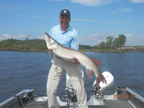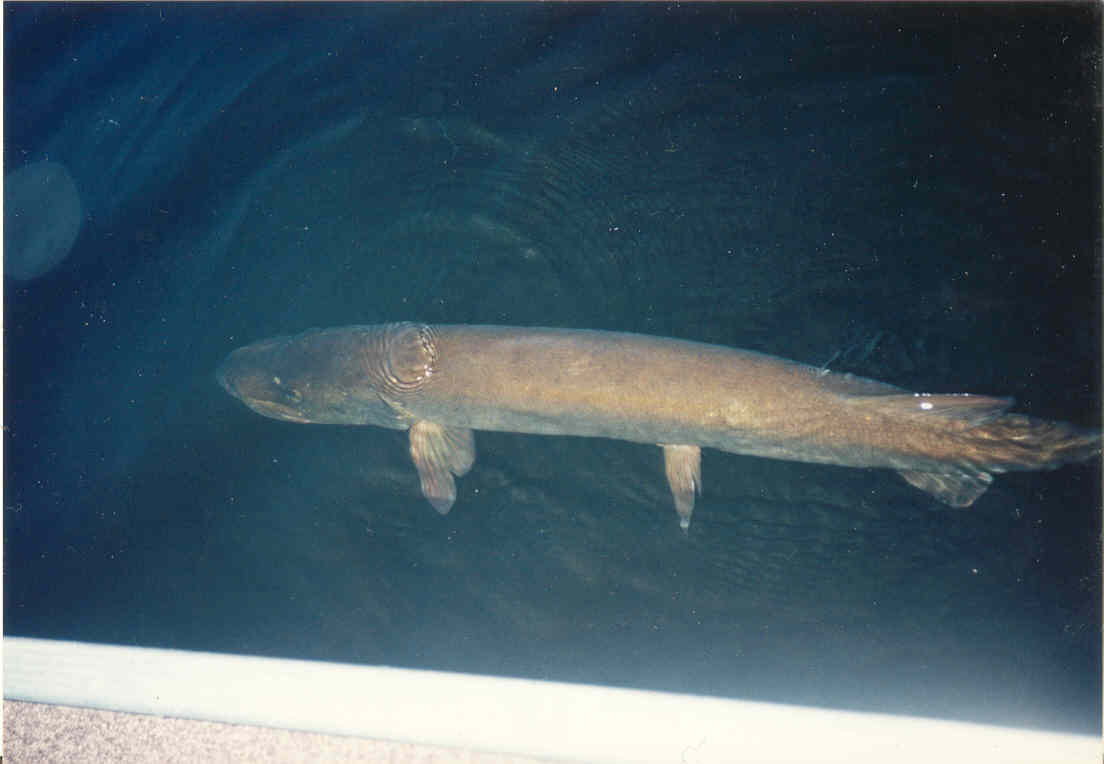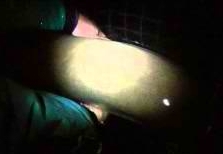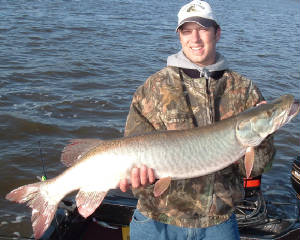|
|

Posts: 3508
Location: Elk River, Minnesota | Just thinking here a little and wondered if there has been any study of colors that muskies cannot see well. I fish extremely clear water, and fish are very tuned into feeding by sight.
Thinking here that since some people are color blind (red and green hues from what I know), are there colors that the muskies do not have the ability to detect or have a hard time detecting?
This in itself is maybe a minute piece of the puzzle since I feel that we need to do something to make our lure stand out from the environment, which will attract attention itself, but if we use a color that the fish cannot see (or see well) we may be missing fish that otherwise might have been teased into striking.
Steve | |
| | |

Posts: 1335
Location: Chicago, Beverly | I know there was one study about Musky and Color done, I want to say the name was Trautman. I found a little info on it at a Musky website from England?? Yeah, doesn't that sound odd, Musky website in England.. Apparently they want to start stocking musky over there.. I'll go back to the site and see if I can find the correct name of the study. I went back to the site, it is Trautman and was from 1981 but am not sure if that was the study that covered Musky site... I did pick this up from the website: The muskie's specializations are focused on improving its performance as a sit and wait predator. The dorsal, caudal and anal fins being set so far back and close together on the body allow for rapid acceleration from a stopped position. They also possess cone cells in their retinas, which gives them color vision. Due to the pores with mechano-recptor sensors that cover the face and lateral line of the muskie, they do not require their eyesight to remain successful predators. They are also able to follow scent trails, and are believed to have an acute sense of smell.
Edited by kevin 1/13/2004 3:12 PM
| |
| | |

Posts: 1938
Location: Black Creek, WI | Steve,
You ask a good question. One, I probably shouldn't dare try to answer myself. However, I've researched this topic quite extensively. I put many of the links to online info that I found on the ERC website at www.esoxresearch.com. Also, Dr. John New's perspective is outlined very nicely here:
http://www.trentu.ca/muskie/biology/biol07.html
| |
| | |

Posts: 1335
Location: Chicago, Beverly | Dr News info seems very close to the stuff I found, I think that might be where they got it from. Thanks for the article. | |
| | |

Posts: 3508
Location: Elk River, Minnesota | O.k....so hues that are more toward the blue end of the spectrum are harder to detect, as per the website
As a copy and paste here:
"Muskies, like most freshwater fishes have cone cells in their retinas, and hence have color vision. However, because of the light transmission properties of freshwater, the dominant lighting in their environment is dominated by longer wavelengths of light, typically in the green to red region of the spectrum. At twilight, the shortwave portions of the spectrum in water may be even further reduced.
Muskie cone cells are therefore characterized by an absence of blue-sensitive pigments. Typically there are two types of cone cells, single cones with a green-sensitive pigment (500-540 nm wavelength peak absorption) and double cones which may have a single red-sensitive pigment at > 600 nm, or two pigments, one at > 600 nm sensitivity and the other at 520-600nm.
So, muskies can see colors, but not into the blue end of the spectrum (blues and purples probably appear as grey to them)." (from the ERC website above)
So...then could it be that when fishing cisco based waters, blues and purples are good because they mimic (in the view of a muskie) the basic color of cisco and whitefish as grey? Purple has been a great color for me, as has been green.
On the other edge of the idea, then, how can green be good in weedy conditions, where the color itself is dampened by the water, thus making the lure blend in more?
ideas?
Jason, I am curious of your opinion here as well...
Steve
| |
| | |

Posts: 32944
Location: Rhinelander, Wisconsin | Keep in mind our lure colors are paint. Green is a combination of blue and yellow. Question is, was the base paint used to create the green blue, or yellow? The blue based paint will show as a grey most of the time, where the yellow based paint will be a brighter grey to a bit yellow or even a dirty white if there is enough light. Purple is blue and red. Red based, it's nealy black under most conditions.If the purple is 'hazed' over a white background, it provides a shadow contrast.Blue based, it is still nearly black much of the time. Also keep in mind that water rapidly removes the longer wavelengths of light (reds), and that process is amplified by particulate. It is true that the literature supports fish in more turbid waters leaning toward the longer wavelenghts, but the actual COLOR is gone pretty quicky. Take a look at a Coke can in 10' in clear, calm water. It will be nealry black where the red used to be. Add to that the reflected light off the surface early and late in the day, wave action breaking up penetration, and other factors, and one begins to realize it isn't real bright in 8' of water at 4PM. Not alot of light means not alot of color. I have always preached contrast as key. I might be all wet, but I believe that in order for the fish to use sight as a component of the strike response mechanism, the fish needs to be able to clearly seperate the bait from the background against which it is viewed at the point of attack. Dark backgound, light colors. Light background, dark colors. When in question, fish with a black lure. | |
| | |

Posts: 2754
Location: Mauston, Wisconsin | VMS- Ahhhhhhh one of the hotly and most thought provoking debates on the MF Research forum. Do a search of last winters threads. Good stuff. However, here's my condensed perspective. Muskies absolutely don't see colors like we do, i.e., colors are totally different, i.e., because of the lack of the third set of cones, But also because the response levels of the cones they do have is probably very different than ours. So all those cool colors we fisherman really like- those sell lures. The colors that really catch fish are a matter of experience, i.e., you have to prove it with the fish. The general consensus seems to be if you had to pick one color for most species - go w/ firetiger. There is a really great article in the In-Fisherman Book #79 June/July 1988 by Ralph Manns-> "Light of Day Determine Fishings Way". Don't let the title fool you, this article covers a lot of territory including fish color vision. I quote- "Fish don't see colors the same way we see them. Anglers can't tell what color a fish thinks a lure is by looking at it." I believe the muskie has been biologically adapted to enhance it's abilities to forage in low light, i.e., the yellow lens of the muskie's eye. How does that affect it's color vision compared to it's closest relative the northern pike. Here's an experiment, the next time you're in Wal-Mart or some other store with sun glass displays. Pick up a pair of yellow ones, put them on and see what your perception of colors around you are. It's really amazing. Puts everything into a new perspective. Perhaps the closest a human can come to visualizing what a muskie sees would be someone who is colorblind w/ a pair of yellow sunglasses. Then again maybe they process the information differently. How the lure appears to a fish or a human in the water is another issue, i.e., because of the color absorbtion of the water itself as Mr. Worrall so apptly points out. Once again there is some good background reading in some of the threads from last winter. Al Warner "All Water is Zalt Water" http://www.zaltnad.com | |
| | |

Posts: 1938
Location: Black Creek, WI | Interesting info pertinant to this discussion:
http://www.schools.net.au/edu/lesson_ideas/optics/optics_wksht4_p1....
It touches upon many of the questions we ask on this forum.
| |
| | |

Posts: 2754
Location: Mauston, Wisconsin | Jason- agree it is a good discussion. However, I do want to point out what I believe is an obvious error in the document. It shows purple/violet as being rapidly absorbed (see attached light_depth.jpg). i.e., it doesn't match what I would expect based on the fact that purple/violet is the shortest visible wavelength (see attached spectrum-1.jpg). Predictably it should penetrate as far or farther than blue. Actual measurements show that purple/violet penetrates as effectively even more so than blue if you use the 1994 data set (see attached water.gif). For more details see-> http://www.deepocean.net/deepocean/index.html?science07.html Here's a couple more links.-> This is a cool practical demonstration of the color spectrum. http://skyserver.fnal.gov/en/proj/advanced/color/whatis.asp#trythis This one has good discussion of color , including additative and subractive theory. http://cinema-tv.usc.edu/instructors/chomyn/pdfiles/light_10.pdfHave fun Al Warner "All Water is Zalt Water" http://www.zaltnad.com
Edited by ESOX Maniac 1/23/2004 5:44 PM
Attachments
----------------
 light_depth.jpg (23KB - 368 downloads) light_depth.jpg (23KB - 368 downloads)
 spectrum-1.jpg (41KB - 343 downloads) spectrum-1.jpg (41KB - 343 downloads)
 water.gif (60KB - 524 downloads) water.gif (60KB - 524 downloads)
| |
| | |

Posts: 2068
Location: Appleton,WI | so then in a simple way I would increase my catch rate by throwing a green and purple baits? | |
| | |

Posts: 1938
Location: Black Creek, WI | Al, good observation on the "error" in that link.
E, perhaps that is why the Pearson Purple Perch is so yummy? Also, design artists know that yellow and purple are opposite one another on the color wheel and therefore offer the greatest contrast. Who knows if this means anything to muskies... but it certainly helps make for a "high vis" color scheme.
I plan to try and throw more Lime Green next year during low light instead of chartruese to see if I can tell a difference between the two. I also plan to try and throw orange more in "bright" conditions or in skinny water. May not mean squat, but it can't hurt to try. | |
| | |

Posts: 2754
Location: Mauston, Wisconsin | Jason- Even with the error, that link has some good stuff, I especially like the discussion about the yellow cornea's. Al Warner "All Water is Zalt Water" http://www.zaltnad.com | |
| | |
Posts: 354
Location: In the slop! | Jason, lime green is fantastic in low light conditions! Maybe just because it is in the water at primetime, whatever, it works. As for the purple and yellow, I will have to tie some bucktails and spinnerbaits to try this summer. It sounds interesting. | |
| |
|
 Question of seeing color
Question of seeing color Question of seeing color
Question of seeing color